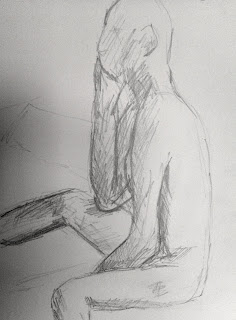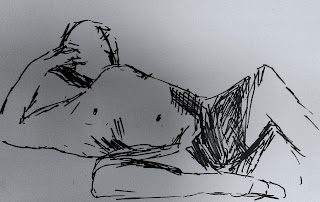6 different poses lasting 10 minutes each.
 |
| 1. sitting charcoal pencil |
My model was not very relaxed which made me uncomfortable. He was tense which showed in his body and I found it very hard to draw him.The first attempt was in charcoal pencil with him perched on the edge of the bed. The balance I caught quite well but due to the speed of the drawing, I could not get the proportions right on the legs and arms.
 |
| 2. sitting pencil |
The second try in pencil did not work at all the proportions are all wrong the near leg is too short and his hand is in mid air with his head resting on nothing.
 |
| 3. kneeling pencil |
The third pencil drawing gave a three dimensional shape with the shading but still the proportions are incorrect the torso is central and the limbs seem to be attached wrongly.
 |
| 4. laying pen |
The pen drawings have a different quality to them but still the proportions were all wrong. The speed drawing did not give me time to correct the drawing.
 |
| 5. sitting pen |
The shoulders were too wide and the elbow too pointed. Another disappointing piece.
 |
| 6. laying charcoal |
Lastly, the charcoal half body laying down. The marks of charcoal on the paper give an impression of shade which in turn adds a quality to the overall drawing. Shading rather than outer lines pleased me in this quick piece.








































